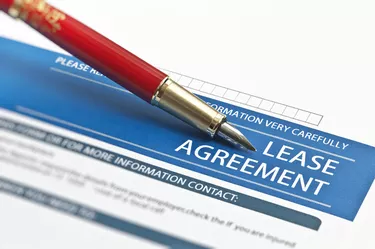
When a company may need the use of an asset but does not intend to purchase it, they often enter into a leasing agreement with another company. In business terms, leasing is much like renting, although the term rent usually refers to the monthly amount paid for a living space such as an apartment. Leases can cover all kinds of assets and simply represent a contract where this asset is provided to the other party in return for regular payments.
Leases and Financial Statements
Video of the Day
There are a few different ways these leases can be recorded within accounting and financial statements, depending on the terms of the contract and the type of agreement. A capital lease is a contract giving the renter the right to use an asset for a specified amount of time. Over this period, the asset is treated as if it is the property of the renter rather than the owner. This makes a capital lease the same as a purchase for accounting purposes.
Video of the Day
Alternately, an operating lease handles the asset as a standard lease and does not transfer any ownership rights to the renter. There are four criteria that determine whether a lease will qualify as capital or operational.
First, the lease period must be at least 75 percent of the asset's expected useful life. Second, the contract must offer the option to purchase the leased asset outright for a value less than its market value. Third, ownership of the asset shifts from the (initial) owner to the renter once the lease agreement is over. Finally, the present value of the lease payments must be at least 90 percent of the asset's market value.
What Is a Capital Lease Amortization Schedule?
To understand how to create a schedule for your upcoming capital lease payments, it's important to understand what present value means in accounting terms. The value of money changes over time; when doing financial accounting, it is assumed that the value of money increases over time. This is due to risk-free interest rates available on the market and general inflation.
Thus, to properly look at longer-term investments and agreements, you often have to back-calculate what they would be worth in present value so that you can accurately compare options over time.
Capital Lease Excel Template
Accounting software can help you create a capital lease schedule, but it can also be completed in Microsoft Excel, says the team at Lease Query. Your first step is to obtain all the conditions of the lease. For instance, you'll need to know how long the contract is, how much is paid and on what kind of schedule, what escalations are expected and what rate(s) the contract controls. Once you have these numbers, you can build a table in Microsoft Excel to step your way through the process.
For example, if your lease lasts for five years, and you're paying $100 per year with an escalation rate of 10 percent, your first payment will be $100. At the end of the first year, you'll pay $110; at the end of the second year, you'll pay $121 and so on. These payments should be straightforward to calculate in a capital lease Excel template.
From there, follow the instructions to fill in the rest of the table using the values that correspond to your particular contract. Using Excel's "Goal Seek" function allows the spreadsheet program to use your inputted information to back-calculate the present value of the lease along with the schedule of values you'll need to use for accounting over the length of the lease terms.
Consider also: How to Calculate Capital Lease Payments